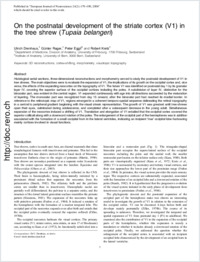On the postnatal development of the striate cortex (V1) in the tree shrew (Tupaia belangeri)
- Drenhaus, Ulrich Department of Medicine, Division of Anatomy, University of Fribourg, Switzerland
- Rager, Günter Department of Medicine, Division of Anatomy, University of Fribourg, Switzerland
- Eggli, Peter Institute of Anatomy, University of Bern, Switzerland
- Kretz, Robert Department of Medicine, Division of Anatomy, University of Fribourg, Switzerland
-
12.07.2006
Published in:
- European Journal of Neuroscience. - 2006, vol. 24, no. 2, p. 479–490
English
Histological serial sections, three-dimensional reconstructions and morphometry served to study the postnatal development of V1 in tree shrews. The main objectives were to evaluate the expansion of V1, the implications of its growth on the occipital cortex and, vice versa, the effects of the expanding neocortex on the topography of V1. The future V1 was identified on postnatal day 1 by its granular layer IV, covering the superior surface of the occipital cortices including the poles. A subdivision of layer IV, distinctive for the binocular part, was evident in the central region. V1 expanded continuously with age into all directions succeeded by the maturation of layering. The monocular part was recognized from day 15 onward, after the binocular part had reached its medial border. In reference to the retinotopic map of V1, regions emerged in a coherent temporo-spatial sequence delineating the retinal topography in a central to peripheral gradient beginning with the visual streak representation. The growth of V1 was greatest until tree shrews open their eyes, culminated during adolescence, and completed after a subsequent decrease in the young adult. Simultaneous expansion of the neocortex induced a shifting of V1. Translation and elongation of V1 entailed that the occipital cortex covered the superior colliculi along with a downward rotation of the poles. The enlargement of the occipital part of the hemispheres was in addition associated with the formation of a small occipital horn in the lateral ventricles, indicating an incipient 'true' occipital lobe harbouring mainly cortices involved in visual functions.
- Faculty
- Faculté des sciences et de médecine
- Department
- Département de Médecine
- Language
-
- English
- Classification
- Biological sciences
- License
- License undefined
- Identifiers
-
- RERO DOC 6370
- DOI 10.1111/j.1460-9568.2006.04916.x
- Persistent URL
- https://folia.unifr.ch/unifr/documents/300293
Statistics
Document views: 64
File downloads:
- kretz_pds.pdf: 178
